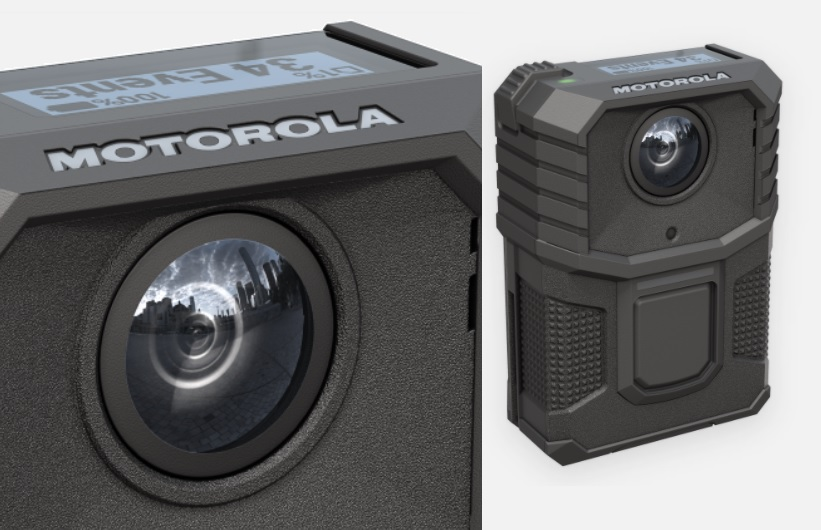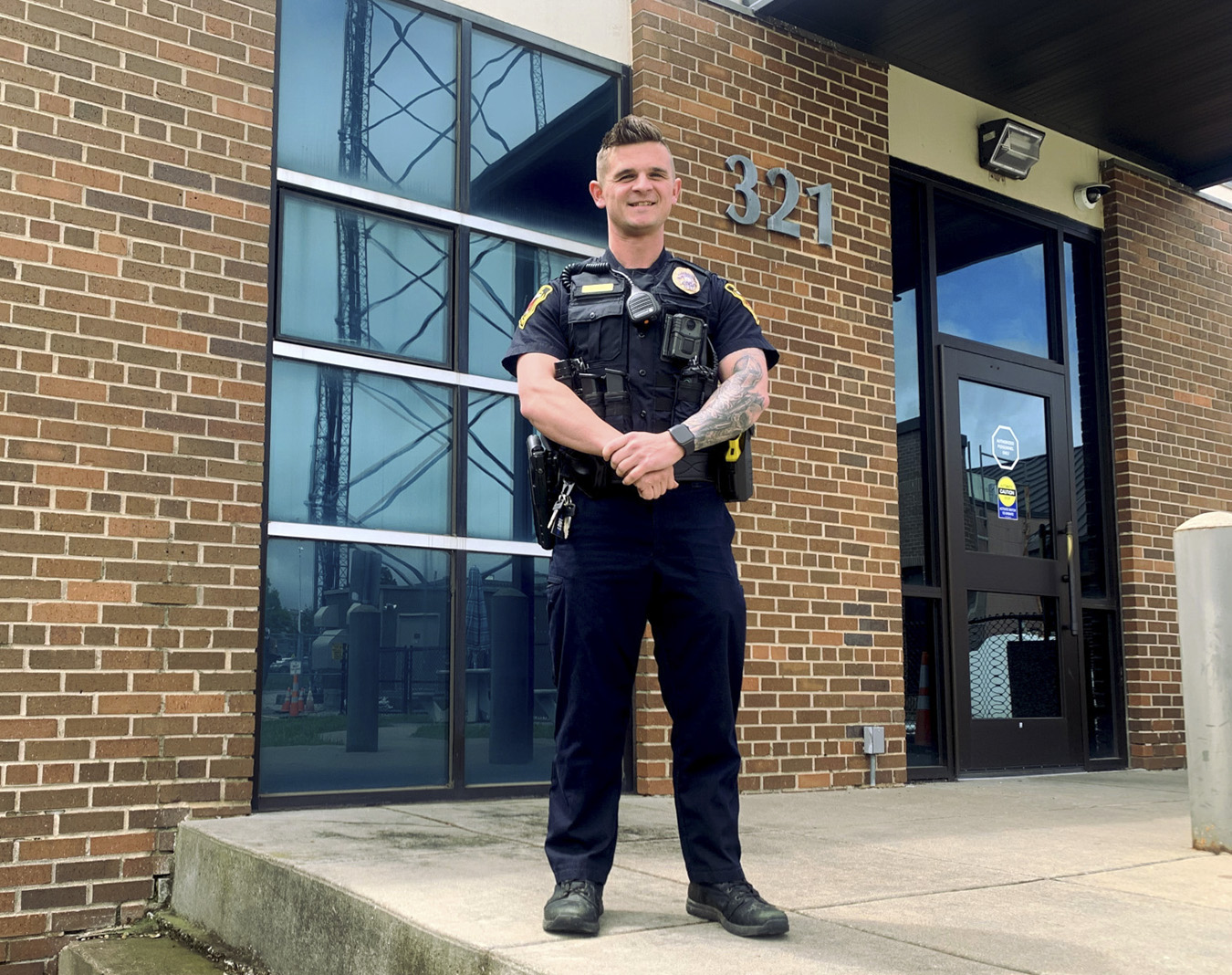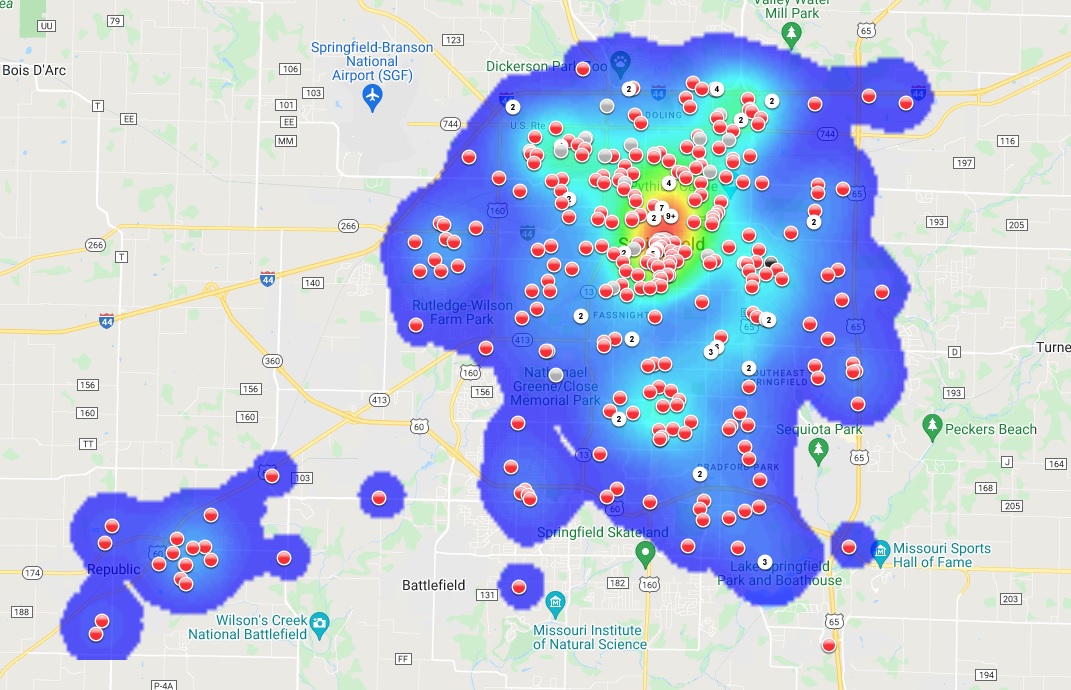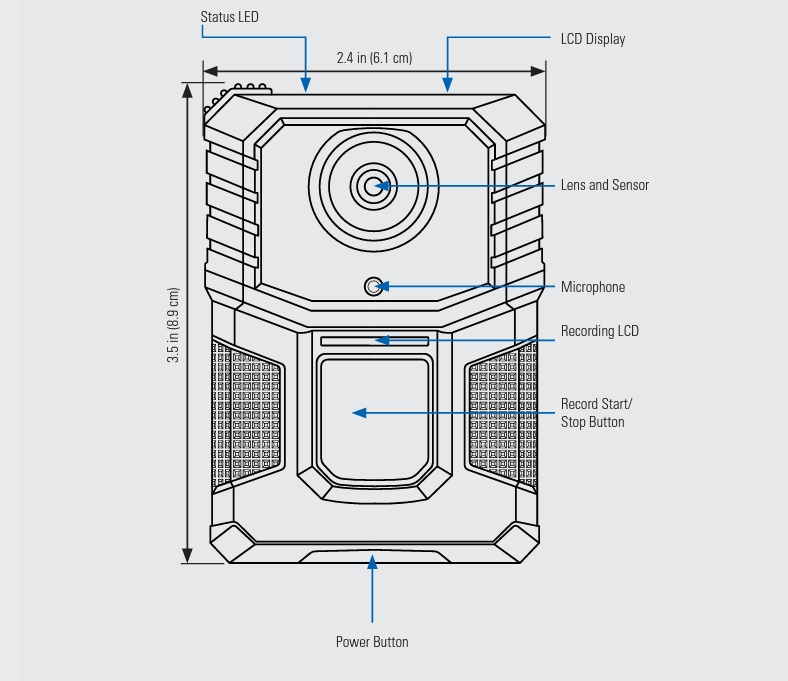It's 7:09 p.m. when Springfield Police Officer Jacob Adams climbs into the driver's seat of a black and white Ford Explorer, his patrol vehicle for the next 12 hours. He's the MCI — the major case investigator — for every bit of Springfield north of Chestnut Expressway on the third shift on the night of April 12, and for the early morning of April 13.
Affixed to Adams' chest alongside his police radio is a Motorola WatchGuard V300, a body-worn camera that will be one of the many pieces of equipment Adams uses to perform his job duties on the overnight shift.
Moments earlier, Adams sat in a briefing room on the lower level of the Springfield Police Department headquarters on Chestnut Expressway. Sgt. Jason Carter, the supervisor that night, offered the officers a parting piece of advice.
“You guys be safe tonight,” Carter said.
Summary
The Springfield Police Department purchased body-worn cameras for all of its police officers at the start of 2021. Every officer on patrol now wears a camera that can record their interactions, interviews and handling of evidence, even if the officer forgets to start recording data. Springfield Police Chief Paul Williams says the cameras have led to a reduction in complaints against police officers and incidents in which officers act in the wrong. The chief and a patrol officer both say the cameras are valuable investigative tools.
Related story: Police deny requests to see footage related to complaints against officers
Big investment up front
Springfield City Council records from 2020 show the Springfield Police Department used $612,376 from the city's 1/4-cent capital improvement sales tax Minor Neighborhood Improvements Fund to purchase 240 body-worn cameras at the end of 2020. That’s an average cost of about $2,557 per camera with accessories.
Springfield Police Chief Paul Williams explained he had wanted Springfield police officers to use body-worn cameras for years, but the death of George Floyd and the events that followed in Minneapolis grabbed enough attention to spur support in Springfield. The call for body-worn cameras became what the Springfield police chief described as “a groundswell, a clarion call,” to equip officers with cameras.
“I've been asking for them, it's a lot of money,” Williams said. “I think council heard that, both from the community saying, ‘Yes, we want them, please find money to do this,' and then me going, ‘Yes, we want them, we'll outfit them as soon as we can.'”
In October 2020, the Springfield City Council unanimously approved spending more than $600,000 for all uniformed Springfield Police Officers to be outfitted with body-worn cameras by early 2021.
Williams said the officers' attitudes toward wearing and using body cameras also took a turn from a quiet reluctance and skepticism to willingness and even wanting to wear cameras while they patrolled Springfield.
“By the time we put them on officers, it was about a 90 percent approval rating inside the department,” Williams said. “I see the benefit. We get recorded a lot anyway. I don't have a problem with somebody seeing what I do because I think I do things the right way.”
Williams said negative comments and skepticism went away as the body camera policy took shape and was introduced to Springfield police officers.
“We had a template for a policy on how we were going to roll it out and how we were going to utilize (cameras),” Williams said. “I said early on that just buying the cameras wasn’t enough. We needed to make sure that we were able to fund the storage of the data and personnel to manage it.”
Williams found that other police departments had to start and stop body camera rollouts and policy development because they lacked the funding and the manpower to implement and sustain them over time. For Williams, the push for cameras was worth it for the value they provide to Springfield police and to the community.
“The camera is the impartial third-party observer,” Williams said.
Why care?
Whether you’ve been an upright citizen your entire life (and intend to keep it that way) or if you’ve had unfavorable experiences with police officers in the past, body-worn cameras are gaining popularity across the United States as impartial third-party observers designed to hold police officers accountable to the communities and the people they serve. They also cost money to buy and operate, to the tune of $612,376 in Springfield sales tax revenue up front plus the costs of two full-time employee salaries and counting to maintain footage in an index.
A night with the major case investigator
Back in the police vehicle, Adams shows me how his body-worn camera works. It mounts to his chest with a magnet, and weighs a little bit more than my iPhone with its protective case. Adams volunteers some thoughts.
“It's so easy to use; that's what I like about it,” Adams said.
He explains what his duties are as I prepare to ride along with him for the first half of the shift. As the major case investigator, Adams will be called to the scene of any deaths, whether they are suspected to be natural deaths, suicides or homicides. He'll also be called to the scenes where it's suspected violent crimes or serious felony property crimes are being committed.
Safety first, he also gives some instructions on what to do “in case I go down.” Adams has been with the Springfield Police Department for almost three years. It’s his first job in law enforcement. Adams previously served in the U.S. Marine Corps.
Officer Adams turns his gaze straight at my face, as we sit eye-to-eye in the patrol vehicle.
“Do you know how to work a shotgun?” Adams asks.
What kind of Missourian would I be?
“Yeah,” I tell him.
He then gives some instructions on how to protect myself as a last resort. I wish the police department would have allowed me to wear athletic shoes, because I would much prefer to run away from trouble than wield a shotgun against anything that isn’t a sporting clay or a game bird. Adams also tells me that if he ends up running after someone in a foot pursuit, I am welcome to follow him. Even though I’m wearing Dockers and dress shoes, I tell him I’ll try.
We made it through the ride-along shift without touching the shotgun or having to run.

Laptop and cell phone apps, and Bluetooth capability
Adams demonstrates the WatchGuard app on the laptop computer, which is positioned on a stand in the front compartment of the vehicle. With the software, he can look at footage taken from his body-worn camera after it has been logged. The memory card on the camera can store up to 101 gigabytes of data, which is more than 80 hours of video in 1080P.
Adams also can use the camera’s Bluetooth capabilities to look at footage on his cell phone.
“I’ll watch it on my phone just a little bit, just to write my report,” he said.
Just to demonstrate, Adams uses the in-car laptop to pull up a video from the archives, a video taken from his body-worn camera in September 2021.
“I don’t know what this is,” Adams said.
It turned out to be a video of Adams speaking to a woman who had some property stolen from her yard. The video is categorized as “evidence.” Adams shows me how he can categorize each piece of video he takes by scrolling through some options on the camera. He can categorize videos of traffic stops separately from interviews with people suspected of committing crimes. He can even label some footage as “no event” but preserve it anyway.

Lights, camera, interviews
An old press release from the Springfield Police Department shows Officer Adams was among 26 persons sworn in to become police officers in August 2019.
In January 2021, Springfield Police Officers began to take training on body cameras. By the end of the month, each officer in Springfield was patrolling while wearing and using a camera. Williams said he is proud there was no gradual rollout, but a single launch day for cameras and the policies that govern them.
“We did 240 of them all on the same day, which I think was a benefit for everyone,” Williams said.
At 7:29 p.m. on April 12, 2022, Officer Adams was in the parking lot of the police station when he received a call over his police radio about a robbery at gunpoint. Two vehicles, a white SUV and a black sedan, were allegedly involved in the theft of a portable welding machine. Adams recognizes the address of a tire shop in north Springfield.
Six minutes later, Adams’ Explorer rolls up to the tire shop. He knows the man who called the police. Before he steps out of the vehicle, Adams reaches across his chest and presses the large button on the front of his body-worn camera. The red light on the front of the camera comes on, indicating that the video is recording.
Adams said he has learned to glance for the red light out of habit. It helps him to remember to activate his camera anytime he steps out of the vehicle.
“If I do forget, by the time I get up there, I realize that it’s off,” Adams said.
Adams discloses he knows the man who called police to report the robbery. He has a history of cooperating with the police department to look for stolen vehicles. Motor vehicles were reported stolen 1,477 times in Springfield in 2021, a 2.4-percent increase from 2020. That's an average of 4.04 vehicles stolen in Springfield on any given day, or a vehicle theft occurring about once every six hours. About 80 percent of the vehicles are recovered, but 20 percent are never found.
“I try to build a rapport with people,” Adams said of his working relationship with the tire shop employee. Later, when discussing the topic of interviewing people in order to probe for information, Adams shared that he reads books about psychology, communication and body language. He enjoys that aspect of his job. The knowledge gained helps Adams spot when he thinks people might be lying to him. Adams said it also helps him spot when a person might suddenly try to run from police officers.
The WatchGuard V300 is equipped with “record after the fact technology” that allows the camera to continuously record and store data, even if the camera is not activated by the user. Software system administrators are able to retrieve data up until the point that the camera has been powered on for such a length of time that it records over the existing data stored on the camera. The length of time is not specified in the policy.
The cameras also store data from the 30 seconds before the user activates a recording, and another 30 seconds after the user stops recording.
“If it's on but not recording, we can go back and grab that recorded footage, and we've utilized that in criminal cases and in officer complaints,” Williams said.
Camera footage is uploaded to a cloud-based storage system provided by the software vendor. Users in the Springfield Police Department are able to access stored files from computer terminals in the police department building, provided they have permission and are not subject to any restrictions.
“It is the policy of the Springfield Police Department to maintain effective chain of custody and evidence control consistent with court admissibility standards to protect the quality of information recorded,” the policy reads, in part.
According to the policy, officers who are issued body cameras (abbreviated “BWC” in the policy language) receive initial training on how to activate the camera and how to navigate its software before they use it in the field. If an officer is promoted, they receive additional body-worn camera training.

‘We hit the deck'
At 7:35 p.m., Adams is one of two northside police officers speaking with the man who was robbed at gunpoint. Two other people also were at the shop when the white SUV and the black sedan reportedly arrived.
The caller, whom Adams remembered by name from before, recounted how a man pointed a pistol at all three people.
“He was screaming all kinds of stuff,” the man said. “We hit the deck.”
He described the pistol as a black semi-automatic. He told police the man with the gun took a portable welding machine that was sitting outside the building and loaded the machine into the white SUV. There were a man and a woman in the SUV, who then drove away with the welder.
“It’s brand new — brand new,” he said of the machine.
The tire shop employee recognized the gunman, and told police about a nearby house where he might have gone. Adams recognizes the house from previous police entanglements.
When Adams is finished talking to the man, he goes back to his Explorer. Adams reaches down and touches the large button on the front of the camera twice in quick succession, which stops the recording.
At 7:57 p.m., Adams is outside a duplex in northwest Springfield. The red light on the camera is back on. He’s the third police officer to arrive at the scene. The first two officers — one is Sgt. Carter — found the white SUV. A man and a woman sit in the driveway with their hands cuffed behind their backs.
Adams gets out another camera — a photographer’s camera used for investigations and for taking photos of evidence — from the back of his Explorer and gets to work taking photographs of the SUV. A new welding machine is sitting in the front passenger seat.
While Adams takes photographs, Carter talks to the man and woman in handcuffs about the welder.
“I was just transportating it for a friend of mine,” the man in cuffs told police.
At 8:04 p.m., with the red lights on the body-worn cameras aglow, police officers load the man and the woman into separate vehicles. They will be booked in jail on suspicion of first-degree robbery.
Adams takes photographs of the welder in the SUV, and then takes photos after officers remove it from the vehicle. He is sure to get a clear photo of the serial number. Police make arrangements to reunite the welder with its owner at the tire shop.
At 8:27 p.m., Adams is back in his vehicle, ready to go back to police headquarters to log evidence and write a report.
“Did you hear what he said?” Adams asks me, referring to the robbery suspect.
“You mean ‘transportating?’” I ask.
“Yeah. That’s the line of the night,” Adams says.
“As someone who works with words, I suppose I can appreciate what he was doing there,” I reply.
“You have to put that in your story,” Adams tells me.
Data storage and times to press ‘record'
Springfield police officers are required to use body-worn cameras to record calls for service when they are dispatched or that they initiate, as well as interactions with the public that are not solely for public relations or casual, all arrests, all arrest attempts, all times when they are transporting prisoners or inmates, searches of persons, searches of vehicles, searches of structures, searches of property, foot pursuits, vehicle pursuits, checks of suspicious persons or vehicles, when they are directing traffic, and when interviewing crime victims, witnesses and suspects.
“Any viewing, copying or deletion of BWC (body-worn camera) recordings shall be done in accordance with the provisions of this policy,” the Springfield Police Department policy reads, in part. “Personnel shall not tamper with or attempt to modify any BWC equipment or recording.”
Springfield police also are required to record all instances in which they apply force to another person, and “any contact that becomes adversarial after the initial contact, in a situation that would not otherwise require recording,” according to the body-worn camera policy.
The policy states that intentionally stopping a recording or intentionally obstructing or shielding the cameras is a violation of the policy that could result in disciplinary action.
Strip searches are not recorded. Officers also may deactivate their camera when speaking to another law enforcement officer who works undercover, when they are interviewing a confidential informant, or when they are in a place where there are expectations of privacy, such as hospitals, public restrooms or locker rooms.
The policy states that officers must deactivate cameras when conducting initial interviews with sexual assault victims.
The policy also spells out the length of time footage and audio from body cameras must be stored before it is purged from cloud storage. The minimum length of time varies depending on the type of case it is associated with. The time ranges from 45 days for “no event” or other non-criminal recordings, all the way to permanent storage for footage associated with the investigation of class A felonies.

Technical specs
The Motorola WatchGuard V300 offers a 130-degree field of view. The camera body is 3.5 by 2.4 inches, and is 1.1 inches thick. The camera is slightly smaller than the iPhone 5, though it is three times as thick. The camera and battery have a combined weight of 6.8 ounces.
The cameras are GPS, Bluetooth and Wi-Fi equipped. The WatchGuard V300 is capable of operation in temperatures as cold as 4 degrees below 0, and up to 140 degrees Fahrenheit, according to the manufacturer.
It takes less than four hours to fully charge the battery for the WatchGuard V300, and it can provide more than 12 hours of operation.
Williams himself gets each request for footage from body-worn cameras that was taken before or after an officer pressed the record button on his/her camera. He reviews the requests himself, he said.
“I probably get one or two a week from an officer saying, ‘Hey, I was involved in this instance, I was interviewing somebody on a burglary or I had to use force, I didn't have time to, or (the camera) didn't click on, or I forgot to, or I didn't think it was going to be something I needed to record. Can I have access to it?'”
The recordings pile up quickly, and are stored and backed up according to police department policies.
“Last time I checked, we had 75,000 pieces of video footage that were stored,” Williams said.
That's from one year, 2021. Each piece of footage is stored for a specified amount of time in accordance with police department policy. Each file is categorized and indexed to prevent it from being lost or inadvertently deleted. Managing body-worn camera footage is a full-time job for two Springfield Police Department employees. It also affects the workloads of several others.
“We agreed to absorb the extra workload,” Williams said. “That is wearing some people out, because there's a small group of our investigative service specialists that are doing that in addition to their other workload. It's really two people who are really focused on it, but there are five or six that can do it.”

